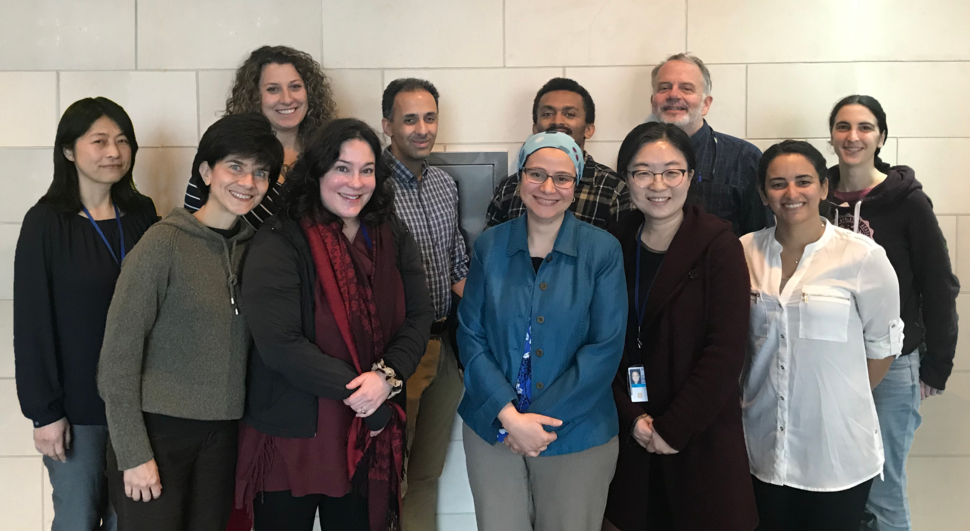Progress Assessing Cancer Risk Using Clinical Practice Research Datalink
, by Maura Kate Costello, M.A.
DCEG scientists investigate risk factors and exposures that may contribute to cancer risk, ranging from medication usage to genetic cancer predisposition, using data from the Clinical Practice Research Datalink.
Leveraging a Robust Data Source
DCEG scientists are using the Clinical Practice Research Datalink (CPRD), a comprehensive database with medical and lifestyle information on 45 million individuals from primary care practices across the United Kingdom (U.K.), to investigate risk factors and exposures that may contribute to cancer risk. Beginning in 2016, Shahinaz Gadalla, M.D., Ph.D., Earl Stadtman investigator in the Clinical Genetics Branch (CGB), has led efforts to establish and expand a data-sharing agreement with CPRD.
In the absence of centralized comprehensive medical records, as is the case in the United States (U.S.), data needed for epidemiologic research have to be collected from a variety of sources—private medical practice records; insurance claims; hospital records; birth and death certificates; registries for cancer and other diseases; clinical trial records; or research cohort studies—which increases the cost, complexity, and time for research, and, for some research questions, can even preclude any assessment. “The U.K. created the CPRD for the express purpose of conducting health research,” explains Dr. Gadalla, “making available in one dataset over 30 years of complete, up-to-date, lifetime patient health records.” These data include patient demographics; lifestyle factors such as smoking, and alcohol use; routine health care records (such as immunizations, cancer screening results, laboratory testing); results from diagnostic laboratory tests and other procedures; clinical events; and full prescription records. Moreover, CPRD offers linkages to the Hospital Episode Statistics dataset for inpatient and outpatient records, cancer incidence data from Public Health England cancer registries, other national registries, and death records from the Office for National Statistics.
The richness of CPRD offers several advantages to epidemiological research. General practitioners in the U.K. are the gateway to all other medical services; therefore, their records include all diagnoses, specialist referrals, and treatment information, making them more complete than those of their U.S. counterparts. Lifetime information allows investigators to evaluate the effect of various exposures and potential risk factors on subsequent disease risk prospectively, without waiting for cancers and other health outcomes to accrue within a newly established cohort. CPRD is a large, representative sample of the population of the U.K., across racial/ethnic groups and socioeconomic strata. Approximately one in six general practitioners submit data to CPRD. In comparison, medical records, and even access to medical care, can vary widely across the U.S., so individual data sources are rarely representative of the general population and may not capture diverse populations. SEER-Medicare, a more comprehensive and representative database in the U.S., is limited to persons over age 65, and therefore misses diseases with young onset and poor survival, whereas CPRD covers all ages.
Medication Use and Cancer Risk
CPRD offers a valuable resource for investigating the lifetime effects of medication use across a population. As such, these investigations may uncover important health outcomes, benefits such as disease prevention, and/or harmful late effects associated with use of those drugs that would otherwise go unobserved in clinical trials or other studies that only follow patients for a short period of time. The database also provides “real world evidence” for the effects of medications, which is a valuable complement to data from highly selective clinical trials. Katherine McGlynn, Ph.D., M.P.H., senior investigator the Metabolic Epidemiology Branch (MEB), and collaborators used CPRD data to investigate whether several widely used medications affect the risk of liver cancer, the incidence of which has been increasing rapidly in the U.S. and UK. In a series of publications, they have reported that certain medications were not associated with reduced risk of primary liver cancer:
- Association of nonsteroidal anti-inflammatory drugs (NSAID) use with risk of primary liver cancer (Yang B et al, Cancer Epidemiol 2016)
- Associations of antibiotic use with risk of primary liver cancer (Yang B et al, Br J Cancer 2016)
- Anti-diabetic medications and risk of primary liver cancer in persons with type 2 diabetes (Hagberg KW et al, Br J Cancer 2014)
- Does angiotensin-converting enzyme inhibitors and beta-blocker use reduce risk of primary liver cancer? (Hagberg KW et al, Pharmacotherapy 2016)
While these findings need to be validated in other populations, they suggest these medications are unlikely to be good candidates for chemoprevention of liver cancer. Use of statins, common medications used to lower cholesterol, was associated with reduced liver cancer risk, particularly among individuals with type 2 diabetes and liver disease (McGlynn KA et al, J Natl Cancer Inst 2015). Jake E. Thistle, M.P.H., former postbaccalaureate fellow in MEB, and Dr. McGlynn also found that domperidone, a medication that stimulates prolactin production, was not associated with elevated liver cancer risk, except among women who received the highest doses (Thistle JE et al, Cancer Epidemiol 2018).
Use of bisphosphonates—medications to prevent or treat osteoporosis, particularly among postmenopausal women—increased dramatically in the U.S. and elsewhere at the turn of the century. This drug can cause severe esophagitis when taken incorrectly, which raised concerns that it may be associated with risk for esophageal cancer. Using data from the General Practice Research Database (GPRD), a precursor to CPRD, Christian Abnet, Ph.D., M.P.H., senior investigator and chief of MEB, and collaborators found that oral bisphosphonate use was not significantly associated with esophageal or gastric cancer risk (Cardwell CR et al, JAMA 2010). They also explored potential associations with cancer in other organs and found no evidence for concern (Cardwell CR et al, Int J Cancer 2012).
Sarah Jackson, Ph.D., postdoctoral fellow, and Jill Koshiol, Ph.D., Earl Stadtman investigator, both in the Infections and Immunoepidemiology Branch (IIB), found that among nearly 3,000 cases of biliary tract cancer, a rare and severely lethal disease, the use of aspirin after diagnosis was associated with decreased risk of death (Jackson SS et al, JAMA Oncol 2019). Dr. Koshiol and another postdoctoral fellow in IIB, Zhiwei Liu, Ph.D., showed that use of statins prior to the diagnosis of biliary tract cancer was associated with reduced risk of death (Liu Z et al, Gut 2019).
Hormones, Medical Conditions, and Cancer Risk
Menopausal hormone therapy (MHT) is a well-established risk factor for several cancers, however, data on liver cancer are limited. Since primary liver cancer occurs less often among women, scientists hypothesize that hormones may have a protective effect, though prior studies have been inconsistent. In a study of approximately 340 women with liver cancer and 1,300 controls in CPRD, Dr. McGlynn and collaborators found a significantly lower risk of liver cancer among MHT users, especially among users of estrogen-only MHT (McGlynn KA et al, Int J Cancer 2016). In the same vein, Andrea Florio, M.P.H., research analyst, Jessica Petrick, Ph.D., former postdoctoral fellow, both in MEB, and Dr. McGlynn, found that oophorectomy was associated with increased risk of non-alcoholic fatty liver disease, a known risk factor for liver cancer (Florio AA et al, Eur J Epidemiol 2019). Interestingly, oophorectomy was not associated with increased risk of liver cancer. These results support the need for further research into the role of hormones in liver cancer etiology.
Medical conditions that result in inflammation have been found to increase risk of some cancers. For example, gastroesophageal reflux disease (GERD), which causes local, chronic inflammation, is associated with risk for Barrett's esophagus and esophageal adenocarcinoma (EA), but almost half of EA patients do not experience prior symptoms of GERD. Obesity exacerbates GERD and is also a component of metabolic syndrome. Michael Cook, Ph.D., senior investigator in MEB, used CPRD to study risk factors for Barrett's esophagus and EA, dependent on presence or absence of GERD. He found that individuals with metabolic syndrome had a marginally increased risk of Barrett's esophagus in the absence of GERD (Drahos J et al, Cancer Epidemiol 2016). The systemic inflammatory state characteristic of metabolic syndrome may represent a reflux-independent inflammatory pathway that increases the risk of Barrett's esophagus. Notably, metabolic syndrome did not increase risk of EA in this study population, suggesting the need for further research.
Accelerating Study of Rare Diseases
The formidable size and detail within the CPRD facilitate research on rare diseases, which may occur too infrequently in populations represented in other data sources to provide adequate statistical power for meaningful analyses. Parisa Karimi, Ph.D., former fellow in MEB, and Sam Mbulaiteye, M.B.Ch.B., M.Phil., M.Med., senior investigator in IIB, took advantage of the large population included in CPRD to study Burkitt lymphoma (BL), a disease that is endemic in some regions of Africa, Brazil, and Papua New Guinea, but is quite rare in Western countries. In the U.S. and U.K., BL is sporadic, except among immune-compromised individuals, such as patients with HIV or solid organ transplant recipients. Drs. Karimi and Mbulaiteye were able to identify enough BL cases in CPRD—a non-endemic setting—to examine risk factors that may contribute to this disease. They found prior infection with Epstein-Barr virus, malaria, and HIV/AIDS, diagnosis of hepatitis, and use of the immune-suppressing steroid, prednisone, were associated with an increased risk of Burkitt lymphoma (Karimi P et al, Br J Haematol 2018). While Epstein-Barr virus and malaria are known risk factors in endemic populations, it was notable that these conditions were also associated with risk among a population where BL is rare.
Cancer Predisposition Disorders
Some diseases can contribute to increased cancer risk through genetic predisposition. In a study using data from the Swedish Hospital Discharge Register and Danish National Patient Registry, Dr. Gadalla and Mark Greene, M.D., scientist emeritus in CGB, discovered a higher incidence of cancer among patients with myotonic dystrophy (DM), compared to the general population (Gadalla SM et al, JAMA 2011). DM is a rare autosomal dominant multi-system disorder characterized by progressive muscle weakness and myotonia. The exact mechanism for cancer development in these patients is not known. Rotana Alsaggaf, Ph.D., postdoctoral fellow, and Youjin Wang, Ph.D., Research Fellow, both in CGB, along with Dr. Gadalla, validated these findings in CPRD and examined several factors that may influence cancer risk among patients with DM type 1 (DM1).
In a study of approximately 1,000 DM1 patients and 15,000 DM1-free individuals, Dr. Alsaggaf and collaborators observed elevated risk for cancer predominately among DM1 patients with the classic subtype, which is characterized by early adulthood onset and greater disease severity (Alsaggaf R et al, JNCI Cancer Spectr 2018). In a second study, they found that the benign tumor profile among DM1 patients was similar to that reported for cancer (Alsaggaf R et al, Ann Clin Transl Neurol 2019). Furthermore, they reported a possible association between benign tumors and subsequent cancers in a subset of patients, suggesting the need for further research to determine whether benign tumors can act as an indicator of elevated cancer risk. In a third study focusing on DM1 patients with type 2 diabetes, where insulin resistance is a known abnormality, Dr. Alsaggaf reported increased risk of cancer, but not among those using metformin, a common drug used to reduce blood glucose levels (Alsaggaf R et al, Int J Cancer 2019). These results are consistent with experimental data suggesting that metformin may inhibit proliferation of a variety of tumor cells.
In a separate analysis, Dr. Wang observed an excess risk of basal cell carcinoma among DM1 patients, which indicates the need to avoid sun exposure and other skin cancer risk factors, vigilant screening, and early treatment (Wang Y et al, Int J Cancer 2018). Clinically-actionable findings such as these provide opportunities for cancer prevention and have informed the development of clinical management guidelines for this special population.
Opportunities for Development of New Statistical Methods
The CPRD provides an opportunity to develop statistical methods for estimating survival time based on cohorts with either prevalent cases (cases diagnosed before the cohort enrollment period) or incident cases (cases diagnosed after the start of the cohort enrollment period). Survival times from incident cohorts are unbiased and representative of the study population, but the maximum observable time is limited to the duration of the study. Using prevalent cases allows for immediate inclusion of larger numbers of cases observed at various disease durations, but the prevalent cases had to survive their disease up to the time of their recruitment time to be able to enroll in the cohort, and thus are a biased sample of all cases. Data sources with mixed incident and prevalent cases are increasing in number, including the Canadian Longitudinal Study on Aging, other large population-based prospective cohort studies, and medical records databases such as the CPRD. It is critical to develop statistical methods that use all the available data (both cohorts) from such studies and databases, appropriately accounting for potential bias. Ana Best, Ph.D., mathematical statistician in the Division of Cancer Treatment and Diagnosis, and former postdoctoral fellow in the Biostatistics Branch, used CPRD data on patients with DM1 to evaluate the advantages of combining incident and prevalent case data to estimate survival time after disease onset. The combination approach harmonized the advantages and disadvantages and estimated survival times more accurately and precisely than either cohort alone (Wolfson DB et al, Stat Methods Med Res 2019).
Future Directions
Additional studies with CPRD are ongoing. Nicolas Wentzensen, M.D., Ph.D., M.P.H., senior investigator and deputy chief of CGB, Megan Clarke, Ph.D., M.H.S., research fellow, and Sarah Irvin, M.S., predoctoral fellow, both in CGB, are using CPRD to investigate associations between use of lipid-stabilizing and cardiovascular medications with risks of ovarian and endometrial cancers. Maria Constanza Camargo, Ph.D., Earl Stadtman investigator in MEB, Minkyo Song, M.D., Ph.D., postdoctoral fellow in IIB, and Dr. Gadalla are investigating the association of hormone replacement therapy with gastric cancer risk as well as the extent to which autoimmune diseases contribute to risk of cancers of the digestive tract. Dr. Cook is conducting a study examining cancer risk of hormone therapy in prostate and breast cancer patients. Eboneé Butler, Ph.D., postdoctoral fellow in MEB, is investigating the role of reproductive risk factors in relation to prostate cancer risk. Provisional results indicate that prostatitis may contribute to increased risk of prostate cancer among men in the U.K. Maria Teresa Landi, M.D., Ph.D., senior investigator in the Integrated Tumor Epidemiology Branch, is working with Monica D’Arcy, Ph.D., postdoctoral fellow in IIB, and Michael Kebede, M.P.H., postbaccalaureate fellow in ITEB, on Sherlock-lung. They are using CPRD as well as many other data sources worldwide to examine potential associations between medical conditions or medications and lung cancer among non-smokers.


